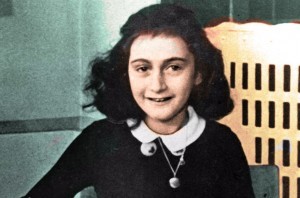In Anne Frank’s diary, begun when she was 13 years old andcut short at 15 by the monstrous events consuming the entire world, it’s thelittle observances that remain shocking all these years later.
Mere months into their hiding, she writes that her mother has a hard time combing her hair “because the family comb has only 10 teeth left.”
The family comb.
Sitting in her temporarily safe little attic space in Amsterdam, she peers through curtains to the street outside and sees some of the remaining, vulnerable Jews out there, who haven’t found hiding places of their own. She feels the first stirrings of survivor’s guilt, “as if I’d denounced them to the authorities and was now spying on their misfortune.”
This is a child bringing us such insights.
She writes, “In everything I do, I can watch myself as if I were a stranger…This self-awareness never leaves me, and every time I open my mouth, I think, ‘You should have said that differently,’ or ‘That’s fine the way it is.’ I’m beginning to realize the truth of Father’s adage: ‘Every child has to raise itself.’”
Some child; some precocious mind on constant alert.
Some children, at age 13, are telling their diaries about a swell new shade of lipstick; some children, at 13, are going steady with a new first baseman’s mitt. Anne Frank, at 13, was writing a diary for the ages.
To mark the 90th anniversary of her birth, June 12, 1929, Bloomsbury Continuum has issued “Anne Frank: The Collected Works.” It goes on sale June 25.
It’s billed as “the first completeedition of Anne Frank’s diary and writings, including newly discovered materialnever before published…in both the version edited for publication by her fatherand the more revealing original, together with her letters, essays andimportant contextual scholarship.”

Ninety years after her birth, Anneis more than a child snatched from life too soon. She’s become the Jewishsaint, the tragic symbol of so much potential lost among the slaughteredmillions.
Also, she’s become public property.The diary was transformed into a Broadway play, which became a Hollywood movie.Countless magazine pieces, newspaper stories, respectful books have examinedAnne and her diary. This past weekend, you could watch a PBS documentary on herlife.
But reading the diary itself is adifferent experience. This is an exceptionally bright and articulate person,but she’s also a teenage girl. She’s examining her looks, falling intosomething like romance, discovering her sexuality and wondering why sex makesthe grownups so uncomfortable.
All of this, while trembling withthe others over every little noise that intrudes upon their hiding place andseems to signal the beginning of the end of their lives – until the end reallydoes arrive.
She writes, in the early going, Jan.15, 1943, “As for us, we’re quite fortunate. Luckier than millions of people.It’s quiet and safe here…The children in this neighborhood run around in thinshirts and wooden clogs. They have no coats, no socks, no caps and no one tohelp them. Gnawing on a carrot to still their hunger pangs, they walk fromtheir cold houses through cold streets to an even colder classroom. Things havegot so bad in Holland that hordes of children stop passers-by in the streets tobeg for a piece of bread.”
She was 13 when she wrote this. Imagine what sensitivity, and what insight and intelligence, she might have brought to all our lives — even today — if she’d only been given that chance.

A former Baltimore Sun columnist and WJZ-TV commentator, Michael Olesker is the author of six books, including “Tonight at 6: A Daily Show Masquerading as Local TV News” (Apprentice House). His most recent, “Front Stoops in the Fifties: Baltimore Legends Come of Age,” was reissued in paperback by the Johns Hopkins University Press.





